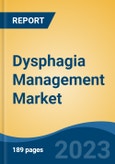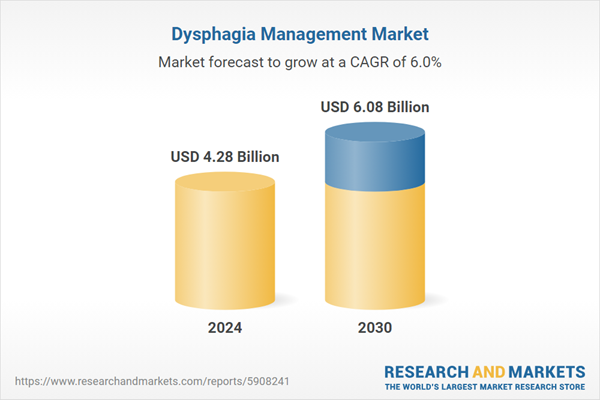Speak directly to the analyst to clarify any post sales queries you may have.
10% Free customizationThis report comes with 10% free customization, enabling you to add data that meets your specific business needs.
Healthcare professionals, including speech-language pathologists, physicians, and otolaryngologists, conduct clinical assessments to evaluate a patient’s swallowing ability. This may involve observation, palpation of the throat, and assessment of oral and pharyngeal function. Diagnostic procedures, such as video fluoroscopy (also called modified barium swallow study) and fiberoptic endoscopic evaluation of swallowing (FEES), offer real-time visualization of the swallowing process, aiding in the identification of dysfunctions. Dysphagia management is an ongoing process, requiring regular follow-up assessments to monitor progress and adjust treatment plans as necessary.
As the global population ages, the incidence of dysphagia increases, particularly among the elderly. This demographic trend is driving the demand for dysphagia management products and services. Growing awareness of dysphagia and its potential complications among healthcare professionals and the general public has led to earlier diagnosis and intervention, further fueling the demand for related solutions. Technological advancements in medical devices, such as modified texture foods, thickening agents, and dysphagia assessment tools, have improved both diagnosis and management, thereby enhancing patient care and quality of life. Healthcare providers are increasingly adopting a patient-centered approach to dysphagia management, tailoring treatment plans to the individual’s specific needs and preferences to optimize outcomes and improve patient satisfaction.
Key Market Drivers
Rising Prevalence of Dysphagia Cases
The global prevalence of dysphagia is estimated to range from 2% to 20% in community settings, with several population-based studies conducted in the United States providing valuable insights. As swallowing disorders become more prevalent, the demand for specialized diagnostic tools, therapeutic interventions, and nutritional solutions is on the rise. This expanding patient base offers significant opportunities for healthcare providers, pharmaceutical companies, and medical device manufacturers.Neurological conditions, such as stroke, progressive supranuclear palsy (PSP), and cognitive decline, are major contributors to dysphagia. Stroke survivors, for example, experience dysphagia in up to 50% of cases, and approximately 80% of PSP patients are affected. These conditions often lead to severe complications, including aspiration pneumonia, malnutrition, and respiratory issues. As life expectancy increases globally, the demand for diagnostic assessments, speech therapy, feeding aids, and modified diets continues to grow.
Key Market Challenges
Compliance with Dysphagia Diets
Dysphagia diets often limit the types of foods and beverages an individual can consume, which can result in monotonous meals, reduced enjoyment of food, and lower overall intake. Texture modifications such as pureeing or mincing can alter the appearance and taste of foods, leading to decreased appetite and satisfaction. Dining in social settings may be challenging as restaurants may not offer appropriate options, causing individuals with dysphagia to avoid social events or gatherings, contributing to social isolation and a diminished quality of life.Additionally, caregivers play a crucial role in preparing dysphagia-friendly meals and monitoring food intake, which can be time-consuming and emotionally demanding. Ensuring adequate nutrition while adhering to texture-modified diets is complex, often requiring consultation with dietitians.
Key Market Trends
Nutritional Interventions
Modified texture diets are designed to make food and liquids safer for individuals with dysphagia by adjusting their consistency to match the patient’s swallowing capabilities. Healthcare professionals, particularly dietitians, collaborate with patients to create customized meal plans that meet nutritional requirements while adhering to necessary texture modifications. Thickened liquids, which reduce the risk of aspiration, are commonly prescribed in varying thickness levels, such as nectar-thick or honey-thick, based on the patient’s swallowing abilities.The market has seen significant innovations in specialized food products, such as pre-packaged pureed meals, thickened soups, and fortified drinks, offering both convenience and nutritional value. Food manufacturers are developing texture-modified foods that mimic the appearance and taste of their regular counterparts to enhance palatability. Additionally, innovations in thickening agents, such as powdered and pre-thickened liquids, provide better consistency and stability for thickened fluids. Nutritional supplements and enteral nutrition products, available in various forms, ensure that individuals with dysphagia receive adequate nutrition.
Key Market Players
- Eisai Co. Ltd
- Becton, Dickinson, and Company
- Hormel Health Labs
- AstraZeneca Plc
- Cipla Ltd
- Nestle Health Science
- Kent Precision Food Group Inc.
- Bracco Diagnostics Inc.
- Phagenesis Ltd
- Cook Medical Inc.
Report Scope:
This report segments the Global Dysphagia Management Market into various categories, including:
By Product:
- Drug
- Feeding Tubes
- Nutritional Solutions
By Indication:
- Oropharyngeal Dysphagia
- Esophageal Dysphagia
By Distribution Channels:
- Hospital Pharmacies
- Retail Pharmacies
- Drug Stores
- Specialty Clinics
By Region:
- North America
- United States
- Canada
- Mexico
- Asia-Pacific
- China
- India
- South Korea
- Australia
- Japan
- Europe
- Germany
- France
- United Kingdom
- Spain
- Italy
- South America
- Brazil
- Argentina
- Colombia
- Middle East & Africa
- South Africa
- Saudi Arabia
- UAE
Competitive Landscape
The report offers detailed profiles and analyses of the major players in the Global Dysphagia Management Market.Available Customizations
TechSci Research offers customizations to this report, enabling it to be tailored to specific needs.- Detailed analysis and profiling of additional market players (up to five).
This product will be delivered within 1-3 business days.
Table of Contents
Companies Mentioned
- Eisai Co. Ltd
- Becton, Dickinson, and Company
- Hormel Health Labs
- AstraZeneca Plc
- Cipla Ltd
- Nestle Health Science
- Kent Precision Food Group Inc.
- Bracco Diagnostics Inc.
- Phagenesis Ltd
- Cook medical Inc.
Table Information
| Report Attribute | Details |
|---|---|
| No. of Pages | 180 |
| Published | February 2025 |
| Forecast Period | 2024 - 2030 |
| Estimated Market Value ( USD | $ 4.28 Billion |
| Forecasted Market Value ( USD | $ 6.08 Billion |
| Compound Annual Growth Rate | 5.9% |
| Regions Covered | Global |
| No. of Companies Mentioned | 10 |









